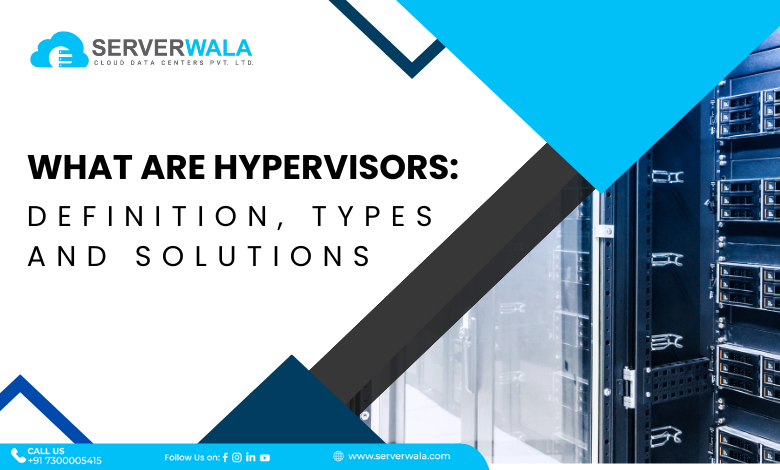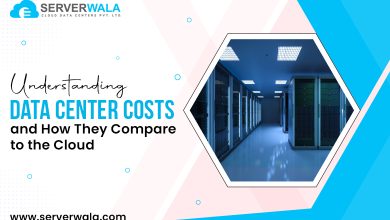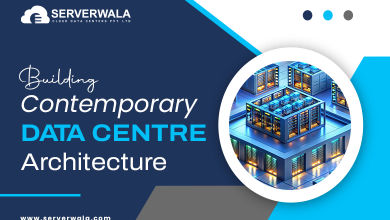What Are Hypervisors: Definition, Types and Solutions

Introduction
In the ever-progressing aspect of virtualization and cloud computing, hypervisors play a pivotal role. Understanding what a hypervisor is and the types available is crucial for navigating the virtual world efficiently.
As entities are taking up the paradigm shift towards cloud computing, the significance of hypervisors becomes even more pronounced. A hypervisor acts as the linchpin, facilitating the creation as well as administration of virtual machines in cloud environments. This evolution has given rise to specialized hypervisor cloud computing solutions, seamlessly integrating virtualization into the fabric of cloud services.
As we delve into the intricacies of hypervisor types, the landscape broadens with diverse solutions catering to various use cases. From enterprise-level deployments demanding the robustness of bare-metal hypervisors to desktop environments benefitting from the flexibility of hosted solutions, the array of options ensures that there’s a hypervisor tailored to every scenario.
What is a Hypervisor?

A hypervisor, often called as a Virtual Machine Monitor (VMM), is a pivotal component in modern computing that facilitates the coexistence of more than one operating systems on a single physical machine. This innovation is vital for resource optimization and efficient hardware utilization.
In the realm of hypervisor types, there are two main categories: Type-1 (bare-metal or native) and Type-2 (hosted or client). Understanding these hypervisor types is essential for tailoring virtualization solutions to specific requirements.
Types of Hypervisors

Type-1: Bare-Metal or Native Hypervisors
Type-1 hypervisors, often called as bare-metal or native hypervisors, are at the forefront of virtualization technology. They function directly on the hardware, bypassing the necessity for a host OS. This direct interaction with the hardware layer makes them highly efficient and well-suited for enterprise-level deployments where performance and resource optimization are paramount.
In essence, Type-1 hypervisors set the stage for robust and efficient virtualization at the hardware level. Their direct interaction with the hardware layer ensures optimal performance, making them the go-to choice for enterprise environments demanding top-notch efficiency and resource utilization.
Type-2: Hosted or Client Hypervisors
Type-2 hypervisors, also known as hosted or client hypervisors, operate on top of a host OS. These hypervisors are devised with flexibility and ease of use in mind, making them apt for desktop or development environments. Unlike their Type-1 counterparts, Type-2 hypervisors introduce an additional layer between the virtual machines and the physical hardware.
Their ease of use makes them particularly well-suited for desktop platforms and development scenarios where agility and convenience are paramount.
List of Bare-Metal Hypervisors

When it comes to deploying bare-metal hypervisors, the choices are diverse, catering to specific needs and preferences. Here, we explore a selection of prominent bare-metal hypervisors, each contributing to the efficiency and scalability of virtualized environments.

VMware ESXi
Renowned as an industry leader, VMware ESXi stands tall in the realm of bare-metal hypervisors. Its reputation for robustness and a feature-rich environment makes it a staple in enterprise-level deployments. ESXi excels in managing virtualized workloads, providing a stable foundation for virtual machines. With features like vMotion and Distributed Resource Scheduler (DRS), VMware ESXi ensures optimal resource utilization and smooth workload migration.

OpenStack
Stepping into the open-source arena, OpenStack emerges as a powerful bare-metal hypervisor within the cloud computing landscape. While OpenStack is primarily recognized as a cloud computing platform, it incorporates hypervisor support as a fundamental component. This allows organizations to harness the benefits of both cloud computing and virtualization, creating a versatile and scalable infrastructure. OpenStack’s modular architecture and broad community support make it an influential pick for those looking for flexibility as well as customization.
KVM
For enthusiasts and organizations deeply rooted in the Linux ecosystem, KVM is a compelling choice. Functioning as a Linux kernel module, KVM transforms the host operating system into a robust hypervisor. KVM’s integration with the Linux kernel ensures efficient resource utilization and tight integration with the host OS. This Type-1 hypervisor empowers users with the flexibility to virtualize diverse workloads on Linux-based systems.
LXC
In the realm of lightweight and efficient container-based virtualization, LXC (Linux Containers) shines as a bare-metal hypervisor. LXC renders a lightweight alternative to traditional virtualization, offering an excellent balance between isolation and resource efficiency. It leverages Linux container technology to create and manage containers, making it an ideal choice for scenarios where overhead needs to be minimized while maintaining strong isolation between workloads.
Proxmox VE
Combining the strengths of two virtualization technologies, Proxmox VE stands out as a comprehensive solution for bare-metal hypervisors. It integrates KVM for managing virtual machines and LXC for light-weight container-based virtualization. Proxmox VE’s web-based management interface simplifies the deployment as well as management of virtualized environments. This feature-rich hypervisor caters to a wide range of use cases, from enterprise-level deployments to enthusiasts exploring virtualization on their own terms.
List of Hosted Hypervisors
When it comes to hosted hypervisors, there is a diverse array of options catering to different needs and preferences. These hypervisors operate on top of a host OS, providing flexibility as well as ease of usage, making them ideal for desktop or development environments.

VMware Workstation Player
Catering to the needs of developers and testers, VMware Workstation Player stands as a leading hosted hypervisor. Its human-friendly interface streamlines the procedure of constructing and managing virtual machines on desktops. Developers appreciate its seamless integration with the host operating system, allowing for the creation of isolated environments for testing applications and software configurations.
VMware Fusion
Tailored specifically for macOS users, VMware Fusion delivers a seamless virtualization experience on Apple hardware. This hosted hypervisor bridges the gap between Mac and Windows platforms, permitting users to operate Windows applications on their macOS devices. With attributes like Unity Mode, which integrates Windows applications into the macOS desktop, VMware Fusion provides a smooth cross-platform experience.
VirtualBox
As an open-source hosted hypervisor, VirtualBox enjoys widespread popularity for its compatibility and user-friendly features. Developed by Oracle, VirtualBox supports diverse guest operating systems, making it a flexible option for virtualization enthusiasts. Its intuitive interface and extensive documentation contribute to its reputation as a go-to solution for both beginners and experienced users exploring virtualization.
Parallels Desktop
Optimized for the seamless integration of Windows on Mac, Parallels Desktop is a hosted hypervisor that caters to users seeking a cross-platform experience. It allows Mac users to run Windows applications alongside macOS applications, eliminating the requirement for dual-boot scenarios. Parallels Desktop offers features like Coherence Mode, providing a unified interface for both operating systems, enhancing user convenience and productivity.
QEMU
QEMU, standing for Quick Emulator, is a versatile emulator and hosted hypervisor that supports various platforms. While it excels as an emulator, QEMU also provides virtualization capabilities, making it a valuable tool for developers and system administrators. Its flexibility allows users to emulate different CPU architectures, providing a broad range of testing environments.
Also Read: How to Reset or Change the Root Password in Linux?
Conclusion
Whether you’re diving into enterprise-level virtualization with bare-metal hypervisors or exploring the flexibility of hosted solutions for personal projects, understanding the types and available options is key. Hypervisors pave the way for efficient resource utilization, scalability, and the seamless coexistence of more than one OSs on a single physical machine. As technology advances, the role of hypervisors in the realms of Linux, cloud computing, and beyond will continue to evolve, shaping the future of virtualization.





